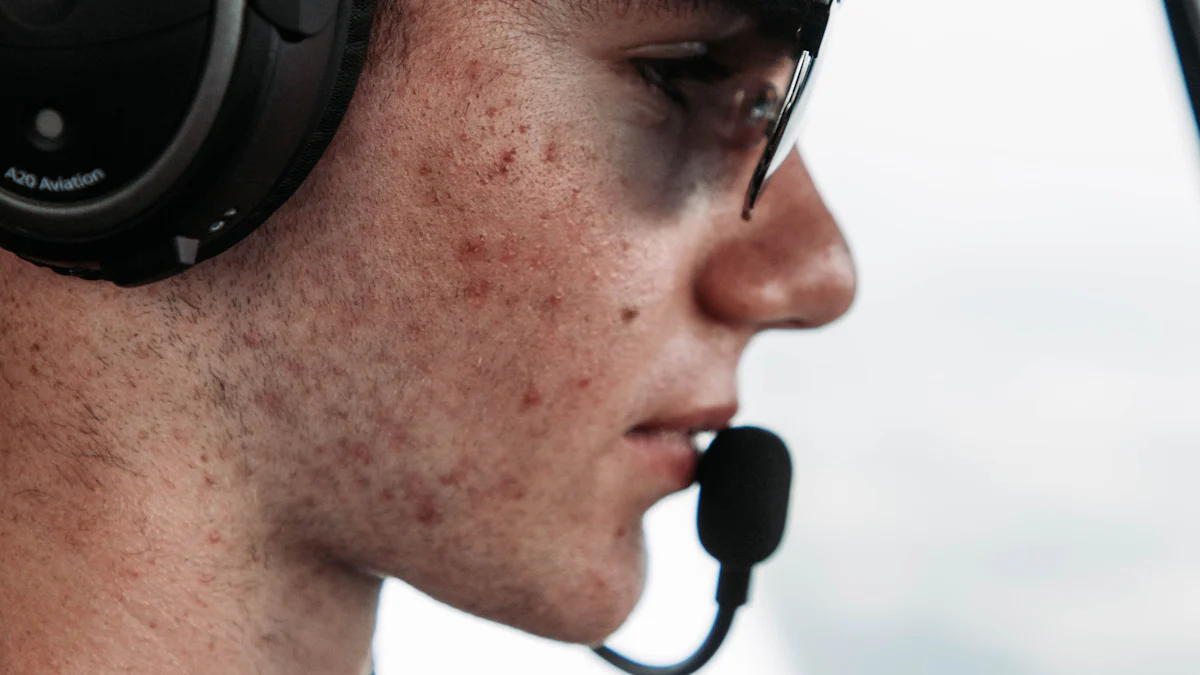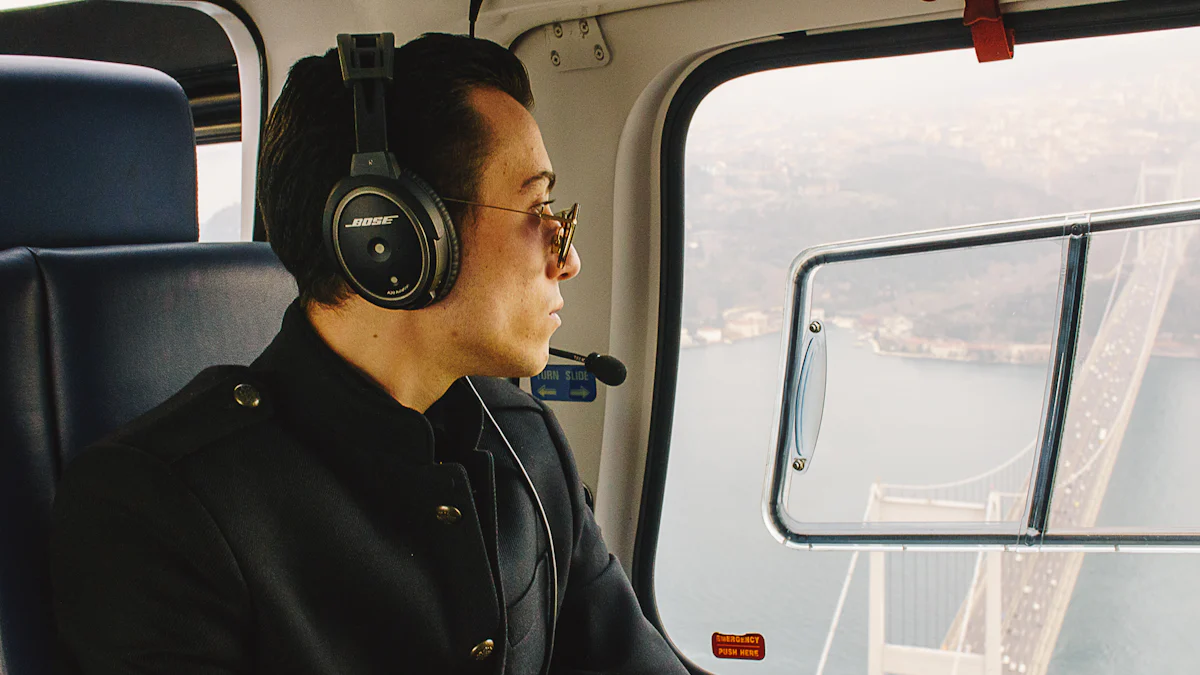Complete Guide to Picking the Best Noise Canceling Headset for Travel

Noise-canceling headphones have become a must-have for any traveler. Whether you're on a plane, train, or bus, they create a peaceful escape by blocking out the constant hum of engines or the chatter of fellow passengers. Unlike regular headphones, noise-canceling headphones use advanced technology to cancel ambient sounds, giving you a more immersive and enjoyable listening experience. The best wireless noise-cancelling headphones also offer unmatched convenience, eliminating tangled cords while delivering high-quality sound. If you’re looking for the best noise-cancelling headphones, consider comfort, portability, and features like the best microphone with noise cancellation for travel on a headset.
Key Takeaways
- Noise-canceling headphones are essential for travelers, providing a peaceful escape from ambient noise during journeys.
- Understand the different types of noise cancellation—active, passive, and adaptive—to choose the best option for your travel needs.
- Prioritize comfort and fit when selecting headphones, as you'll likely wear them for extended periods during travel.
- Look for lightweight and foldable designs to enhance portability and durability, making them easy to carry in your luggage.
- Consider battery life and charging options; long-lasting headphones ensure uninterrupted listening during long trips.
- Evaluate sound quality alongside noise cancellation features to find a balanced pair that meets your audio preferences.
- Test headphones in noisy environments to assess their performance before making a purchase, ensuring they meet your expectations.
Understanding Noise-Canceling Technology

Noise-canceling headphones have revolutionized how you experience sound, especially in noisy environments. Whether you're on a plane, commuting, or simply trying to focus, understanding how these headphones work can help you make the best choice for your needs.
How Noise-Canceling Technology Works
Noise-canceling headphones use advanced technology to reduce unwanted sounds around you. They rely on built-in microphones that pick up ambient noise, such as the hum of an airplane engine or the chatter of a busy café. These microphones then generate sound waves that are the exact opposite (or inverse) of the detected noise. When these opposing sound waves meet, they cancel each other out, creating a quieter listening experience for you.
This process, known as active noise cancellation, is particularly effective at blocking consistent low-frequency sounds like engine rumbles or traffic noise. However, modern advancements have made it possible for some headphones to also reduce mid-range frequencies, such as voices, giving you even more peace in chaotic environments. The result? A more immersive and enjoyable audio experience, whether you're listening to music, watching a movie, or simply enjoying silence.
Types of Noise Cancellation
Not all noise-canceling headphones work the same way. There are different types of noise cancellation, each with its own strengths. Understanding these can help you decide which type suits your travel needs best.
Passive Noise Cancellation
Passive noise cancellation doesn’t rely on technology but instead uses physical barriers to block external sounds. Over-ear headphones with thick padding or in-ear earbuds with snug-fitting tips create a seal that reduces noise. This method works well for high-frequency sounds like conversations or sudden noises. While it doesn’t involve electronics, it’s still an effective way to minimize distractions.
Active Noise Cancellation (ANC)
Active noise cancellation takes things a step further by using electronic components to actively counteract ambient noise. As mentioned earlier, microphones detect external sounds, and the headphones produce inverse sound waves to cancel them out.
Adaptive Noise Cancellation
Adaptive noise cancellation is a more advanced version of ANC. It adjusts the level of noise cancellation based on your surroundings. For example, if you’re walking through a quiet park, the headphones might reduce the intensity of noise cancellation to let in some ambient sounds for safety. In a noisy airport, they’ll ramp up the cancellation to block out the chaos. This feature, often referred to as adjustable noise cancellation, ensures you get the best experience no matter where you are.
By understanding these types of noise cancellation, you can choose the right pair of noise-canceling headphones that match your lifestyle. Whether you prioritize simplicity, excellent noise cancellation, or adaptive features, there’s a perfect option out there for you.
Identifying Your Travel Needs
selecting the right features ensures a seamless and enjoyable travel experience.
Comfort and Fit
The fit of your noise-cancelling headphones can make or break your travel experience. You’ll likely wear them for hours, so finding a comfortable option is essential. Let’s explore the three main styles to help you decide.
Over-ear, On-ear, and In-ear Options
-
Over-ear headphones: These headphones completely cover your ears, providing excellent passive noise isolation. They’re ideal for long flights or train rides, offering plush ear cushions that reduce pressure. Models like the Sony WH-1000XM5 deliver both comfort and superior noise cancellation, making them a favorite for frequent travelers.
-
On-ear headphones: These rest on your ears rather than around them. They’re lighter and more compact than over-ear options, but they may not block as much noise. If you prefer something less bulky, on-ear headphones could be a good compromise.
-
In-ear options: Noise-cancelling earbuds, such as the Bose QuietComfort Ultra Earbuds, are perfect for travelers who value portability. They fit snugly in your ears, creating a seal that blocks external noise. These earbuds combine comfort with advanced noise-canceling technology, making them a top choice for those who want a lightweight solution.
Choosing the right fit depends on your preferences and travel habits. Over-ear headphones offer maximum comfort, while noise-cancelling earbuds provide unmatched convenience.
Portability and Durability
Traveling often means packing light, so your noise-cancelling headphones should be easy to carry and durable enough to withstand frequent use. Portability and durability go hand in hand when selecting the best travel companion.
Lightweight and Foldable Designs
Look for headphones with a lightweight design to avoid adding unnecessary weight to your luggage. Foldable models, like the Sony WH-CH710N, are especially convenient. They collapse into a compact size, making them easy to store in your carry-on or backpack. Noise-cancelling earbuds also excel in portability, fitting neatly into small cases that slip into your pocket.
Durability is equally important. High-quality materials ensure your headphones can handle the rigors of travel. Whether you’re tossing them into a bag or using them daily, a sturdy build guarantees they’ll last for years.
Battery Life and Charging
Long trips demand headphones with reliable battery performance. Nothing disrupts a peaceful journey more than running out of power mid-flight. Prioritizing long battery life ensures uninterrupted listening.
Long Battery Life for Travel
Many noise-cancelling headphones now boast impressive battery life. For instance, the Sony WF-1000XM5 Wireless Earbuds offer extended playtime, perfect for long-haul flights. Over-ear models like the Bose QuietComfort series provide up to 30 hours of battery life, ensuring you won’t need to recharge frequently.
Wireless noise-cancelling earbuds often come with charging cases that provide additional power on the go. This feature is invaluable for travelers who need quick top-ups during layovers or commutes. Fast-charging capabilities are another bonus, giving you hours of use with just a few minutes of charging.
When selecting your headphones, consider how often you’ll have access to charging points. A pair with long battery life and fast-charging options will keep you connected throughout your journey.
By focusing on comfort, portability, and battery life, you can find the best noise-cancelling headphones or earbuds to suit your travel needs. Whether you prefer over-ear headphones for their plush fit or noise-cancelling earbuds for their compact design, the right choice will enhance your travel experience.
Evaluating Key Features of the Best Noise-Cancelling Headphones

When picking the best noise-cancelling headphones, understanding their key features can help you make a smarter choice.
Sound Quality
The sound quality of your headphones can make or break your listening experience. Whether you’re enjoying music, podcasts, or movies, you want every note and word to sound crisp and clear.
Balancing Noise Cancellation and Audio Performance
Finding the right balance between the noise cancelling feature and audio performance is essential. Some headphones focus heavily on noise cancellation but compromise on sound clarity. Others deliver exceptional sound quality but may not block out noise as effectively. For example, the Sony WH-1000XM5 excels in both areas, offering outstanding ANC and rich, detailed audio. Similarly, the Bowers & Wilkins PX7 S2e headphones are known for their superb, detailed sound, making them a favorite for audiophiles.
If you’re looking for noise-cancelling earbuds, models like the Bose QuietComfort Ultra Earbuds combine immersive audio with advanced noise cancellation. These earbuds ensure you don’t have to choose between blocking out the world and enjoying high-quality sound. Always test headphones to see how well they balance these two features.
Price and Value
Price often plays a big role in your decision. But does a higher price always mean better value? Not necessarily. Let’s explore how to weigh your options.
Budget-Friendly vs. Premium Options
If you’re on a budget, you’ll find plenty of great options in the market. The Anker Soundcore Life Q30 offers good noise cancellation and long battery life at an affordable price. These are some of the best budget noise-cancelling headphones for travelers who want solid performance without breaking the bank.
On the premium side, models like the Apple AirPods Max and Sennheiser MOMENTUM 4 Wireless deliver exceptional sound quality, build, and features. The Bose QuietComfort Ultra also stands out with its excellent ANC and immersive audio. While these options cost more, they often include advanced features like adaptive noise cancellation and superior materials, which enhance durability and comfort.
When deciding, think about how often you’ll use your headphones and what features matter most to you. Sometimes, spending a little extra upfront can save you from needing a replacement later.
Additional Functionalities
Beyond sound and price, extra features can make your headphones even more useful. Let’s dive into some functionalities that can elevate your travel experience.
Best Microphone with Noise Cancellation for Travel on a Headset
The best microphone with noise cancellation for travel on a headset ensures your voice comes through clearly, even in noisy environments.
Wireless headphones with built-in microphones also add convenience. You won’t have to deal with tangled cords, and you’ll enjoy the freedom to move around during calls. Look for headphones that combine a great mic with reliable noise cancelling feature for the best results.
Privacy Features and Ambient Sound Modes
Privacy features and ambient sound modes can make your headphones more versatile. Privacy features, like adjustable noise cancellation, let you control how much outside noise you block. This is especially useful in situations where you need to stay aware of your surroundings, like walking through a busy airport.
Ambient sound modes, found in models like the Sony WH-1000XM5, allow you to hear important sounds without removing your headphones. These modes are perfect for announcements or quick conversations. Noise-cancelling earbuds like the Samsung Galaxy Buds Pro also offer similar features, making them a compact yet powerful option for travelers.
By focusing on sound quality, price, and additional functionalities, you can find the perfect pair of noise-cancelling headphones or noise-cancelling earbuds for your needs. Whether you prioritize the best microphone with noise cancellation for travel on a headset, immersive audio, or budget-friendly options, there’s a model out there that’s just right for you.
Tips for Testing and Choosing the Best Noise-Cancelling Headphones
Finding the perfect noise-cancelling headphones can feel overwhelming with so many options available. Testing and comparing models ensures you make a choice that fits your needs. Let’s explore how to evaluate their performance and make a confident decision.
Testing Noise Cancellation
Testing the noise cancellation feature is essential before committing to a pair of headphones. You want to ensure they perform well in real-world scenarios.
Evaluating Performance in Noisy Environments
To test the performance of noise-cancelling headphones, try them in environments that mimic your travel conditions.
If possible, test the headphones with and without music. This helps you understand how well they cancel noise when you're not listening to anything. Many users report feeling less drained during long trips when using active noise-cancelling headphones. This reduction in fatigue highlights the importance of choosing a model with excellent noise cancellation.
Comparing Models
Once you’ve tested the noise cancellation, compare different models to find the best fit for your lifestyle. Researching and gathering feedback can save you from making a costly mistake.
Researching Reviews and User Feedback
Online reviews and user feedback provide valuable insights into the performance of noise-cancelling headphones. Look for reviews that mention specific features like battery life, comfort, and sound quality. For example, users often praise the Bose QuietComfort series for their comfort during long flights and the Sony WH-1000XM5 for their superior wireless capabilities.
Pay attention to feedback about durability and reliability. Frequent travelers need headphones that can withstand regular use.
"I’ve used the Sony WH-1000XM5 on multiple long-haul flights, and they’ve been a game-changer. The noise cancellation is so effective that I barely notice the engine noise anymore." – A frequent traveler’s review.
Making the Final Decision
After testing and comparing, it’s time to decide which pair of noise-cancelling headphones suits you best. Consider your priorities and how each model aligns with them.
Balancing Features, Price, and Travel Needs
Think about what matters most to you. Do you prioritize comfort for long flights, or do you need a lightweight, wireless option for daily commutes? Over-ear models like the Bowers & Wilkins PX7 S2e offer plush comfort and excellent sound quality, while noise-cancelling earbuds like the Bose QuietComfort Ultra Earbuds provide unmatched portability.
Price is another critical factor. Budget-friendly options like the Anker Soundcore Life Q30 deliver solid performance without breaking the bank. Premium models, such as the Apple AirPods Max, come with advanced features like adaptive noise cancellation and superior build quality. Weigh the cost against the features you’ll use most often.
Finally, think about your travel habits. If you frequently take long trips, prioritize headphones with long battery life and fast-charging capabilities. Wireless headphones with foldable designs are ideal for travelers who value convenience and portability.
By testing, comparing, and evaluating your options, you’ll find noise-cancelling headphones that enhance your travel experience. The right pair will make your journeys more enjoyable, whether you’re escaping the hum of an airplane or relaxing in a bustling café.
Choosing the right noise-cancelling headphones can transform your travel experience. These headphones don’t just block out noise; they create a personal sanctuary, whether you’re on a plane, train, or bus. Testing different models helps you find the perfect fit for your needs. Prioritize comfort, sound quality, and features like wireless convenience to ensure you get the most value. As Lisa, a frequent flyer, shared, noise-cancelling headphones allow you to rest, work, or enjoy entertainment in peace. The right pair will make every journey more enjoyable and leave you feeling refreshed and ready to explore.
FAQ
How do noise-canceling headphones work?
Noise-canceling headphones use active noise cancellation technology to block out unwanted sounds.
Are noise-canceling headphones safe?
Yes, noise-canceling headphones are completely safe to use. They don’t emit harmful frequencies or cause damage to your ears. In fact, they can protect your hearing by reducing the need to crank up the volume in noisy environments. If you’ve ever worried about safety, rest assured that these headphones are designed with your well-being in mind.
Do noise-canceling headphones work without music?
Absolutely! Noise-canceling headphones work effectively even when no music is playing. The noise cancellation feature operates independently, creating a quieter environment for you. This makes them perfect for moments when you just want peace and quiet, like during a long flight or while working in a noisy space.
Do noise-canceling headphones hurt your ears?
No, noise-canceling headphones shouldn’t hurt your ears. They’re designed to reduce ambient noise without causing discomfort. However, if you experience any pressure or discomfort, it might be due to the fit or prolonged use. Choosing a pair with a comfortable design, like over-ear models with plush padding, can help prevent this issue.
Do noise-canceling headphones work on airplanes?
Yes, noise-canceling headphones are highly effective on airplanes. They excel at reducing the consistent drone of airplane engines, making your flight more comfortable. Many travelers consider them essential for long-haul flights, as they help create a peaceful environment for rest or entertainment.
Can noise-canceling headphones improve focus?
Yes, noise-canceling headphones can significantly improve your focus. By blocking out distractions, they create a quieter space for you to concentrate. Whether you’re working in a busy office or studying in a noisy café, these headphones can help you stay on task and boost productivity.
What’s the difference between active and passive noise cancellation?
Active noise cancellation uses electronic components, like microphones and sound waves, to cancel out ambient noise. Passive noise cancellation, on the other hand, relies on physical barriers, such as ear cups or snug-fitting earbuds, to block external sounds. Both methods are effective, but active noise cancellation is better for reducing consistent low-frequency noises, like engine hums.
How long does the battery last on noise-canceling headphones?
Battery life varies depending on the model. Many high-quality noise-canceling headphones, like the Bose QuietComfort series, offer up to 30 hours of battery life on a single charge. Noise-canceling earbuds often come with charging cases that provide additional power, ensuring you stay connected during long trips. Always check the specifications to find a pair that matches your travel needs.
Can I use noise-canceling headphones for phone calls?
Yes, most noise-canceling headphones come with built-in microphones, making them great for phone calls. Some models even feature noise-canceling microphones, ensuring your voice comes through clearly, even in noisy environments. This makes them ideal for virtual meetings or catching up with friends while on the go.
Are noise-canceling headphones worth the investment?
If you value peace and quiet, noise-canceling headphones are absolutely worth the investment.
See Also
Exploring My Path to the Perfect Meeting Room Camera
Selecting the Ideal 360-Degree Camera for Your Meetings
Finding the Right Webcam for Your Huddle Room
